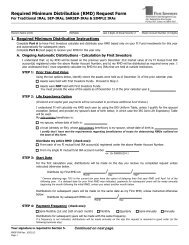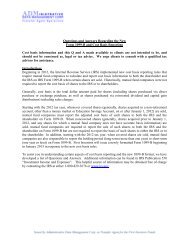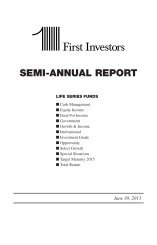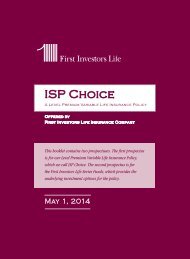The Tax Tamer ® I - First Investors
The Tax Tamer ® I - First Investors
The Tax Tamer ® I - First Investors
- No tags were found...
Create successful ePaper yourself
Turn your PDF publications into a flip-book with our unique Google optimized e-Paper software.
periodic payment exception, changes to Yoursystematic payments before You reach age591/2or within five years (whichever is later)after beginning Your systematic paymentswill result in the retroactive imposition of the10% tax penalty with interest. Otherexceptions may apply under certaincircumstances. Special rules may also applyto the exceptions noted above.If the Contract was purchased as aninvestment for profit, subject to certain rules,you may deduct any loss upon surrender ofthe Contract as an ordinary loss.For purposes of surrenders, the InternalRevenue Code treats all Contracts that Weissue to You in the same calendar year as asingle Contract.Death BenefitsUnlike the death benefit on a life insurancepolicy, the death benefit paid on an annuityContract does not pass to the Beneficiary freeof income taxes. Generally, a death benefit isincluded in the income of the recipient asfollows:• if distributed in a lump sum, it is taxedin the same manner as a surrender of theContract;• if distributed under an annuity payoutoption, it is taxed in the same manner asannuity payments.<strong>The</strong> death benefit paid to a Beneficiary on aContract is ordinary income to theBeneficiary to the extent it exceeds theContractowner’s investment in the Contract.<strong>The</strong> Beneficiary must pay taxes on thisamount at the Beneficiary’s tax rate.Moreover, the death benefit may also betaxed in the Contractowner’s estate unlessthe Beneficiary is the spouse. If theBeneficiary is not the spouse, the Beneficiarymay be eligible for a special income taxdeduction for a portion of the estate taxattributable to the death benefit.Transfers, Assignments and ContractExchangesTransferring or assigning ownership of theContract, changing Annuity CommencementDates or exchanging a Contract (unless theexchange qualifies as a tax-free exchangeunder Section 1035 of the Internal RevenueCode) may result in certain taxconsequences, such as income and gift taxes,not explained in this prospectus.<strong>Tax</strong> Withholding and Reporting<strong>The</strong> Internal Revenue Code generallyrequires Us to withhold income tax from anyContract distribution, including a partialwithdrawal or total surrender or an annuitypayment. <strong>The</strong> amount of withholdingdepends, in part, on whether the payment is"periodic" or "non-periodic."For periodic payments (e.g., annuitypayments), upon request We withhold fromthe taxable portion of each payment basedon a payroll withholding schedule thatassumes a married recipient claiming threewithholding exemptions. If You want Us towithhold on a different basis, You must filean appropriate withholding certificate withUs. For non-periodic payments (e.g.,distributions such as partial withdrawals),We generally withhold 10% of the taxableportion of each payment.You may elect not to have the withholdingrules apply. For periodic payments, Yourelection is effective for the calendar year forwhich You file it with Us, and for eachsubsequent year until You amend or modifyit. For non-periodic payments, an election iseffective when You file it with Us, but only forthe payment to which it is applicable. Wehave to notify Your recipients of Your right toelect not to have taxes withheld.<strong>The</strong> Internal Revenue Code generallyrequires Us to report all payments to theInternal Revenue Service.Other <strong>Tax</strong> IssuesWe are taxed as a “life insurance company”under the Internal Revenue Code. We do notexpect to incur any federal income tax as a21
















